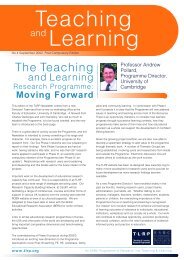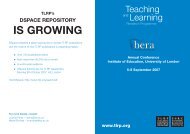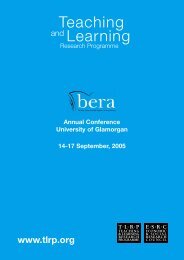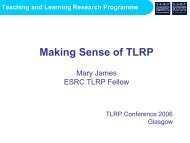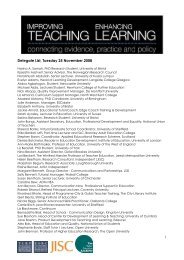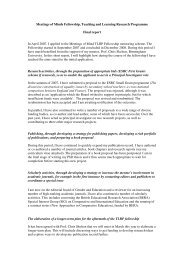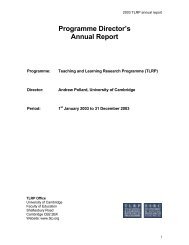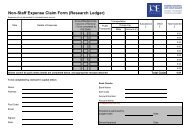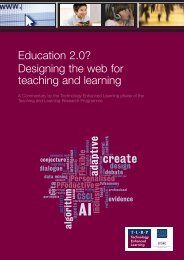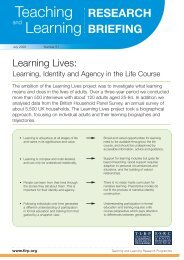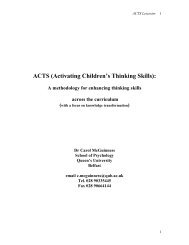4 LEARNING COMMUNITIESEvery teachermattersTERI PENGILLEYAs a formerassistant edi<str<strong>on</strong>g>to</str<strong>on</strong>g>rof The TimesEducati<strong>on</strong>alSupplement, I washeavilyinfluenced bysomething the educati<strong>on</strong>al<str<strong>on</strong>g>research</str<strong>on</strong>g>er and former teacherMary Jane Drumm<strong>on</strong>d <strong>on</strong>cesaid <str<strong>on</strong>g>to</str<strong>on</strong>g> me. She said she’d like <str<strong>on</strong>g>to</str<strong>on</strong>g>read about teachers thinking.Not necessarily reachingsoluti<strong>on</strong>s, but examiningquesti<strong>on</strong>s very hard, tryingthings out and sharing theirreflecti<strong>on</strong>s.In recent years, some haveargued that it is possible for<str<strong>on</strong>g>research</str<strong>on</strong>g> <str<strong>on</strong>g>to</str<strong>on</strong>g> determine “whatworks” in teaching – offeringcategoric answers <str<strong>on</strong>g>to</str<strong>on</strong>g> the knottydilemmas of <str<strong>on</strong>g>practice</str<strong>on</strong>g> and policy.The Teaching and LearningResearch Programme and itsmany projects are more modestand realistic. In additi<strong>on</strong> <str<strong>on</strong>g>to</str<strong>on</strong>g> theinsights from particularprojects, they propose <str<strong>on</strong>g>evidence</str<strong>on</strong>g>informedprinciples <str<strong>on</strong>g>to</str<strong>on</strong>g> help withreflecti<strong>on</strong> and analysis, butrarely hard and fast answers.They recognise that <strong>on</strong>e-sizefits-allsoluti<strong>on</strong>s are much like<strong>on</strong>e-size-fits-all garments – theyd<strong>on</strong>’t actually fit any<strong>on</strong>e exceptthat mythical average child.What comes across clearlyfrom every project, though, isthe importance of fostering thewhole school as a learningcommunity, for teachers,parents and of course children.Findings from across theprogramme dem<strong>on</strong>strate thatteacher learning is essential <str<strong>on</strong>g>to</str<strong>on</strong>g>children’s learning. In order <str<strong>on</strong>g>to</str<strong>on</strong>g>help children <str<strong>on</strong>g>to</str<strong>on</strong>g> becomereflective learners, teachers firsthave <str<strong>on</strong>g>to</str<strong>on</strong>g> develop this dispositi<strong>on</strong>for themselves.There are even statistics <str<strong>on</strong>g>to</str<strong>on</strong>g>support this idea. Performancetables for 2002-4 comparingpupils from Learning How <str<strong>on</strong>g>to</str<strong>on</strong>g>Learn project schools with theprogress of those in similarschools show that three of thefour schools with the highestvalue added had high levels ofengagement with the projectand explicit strategies <str<strong>on</strong>g>to</str<strong>on</strong>g> supportteachers’ professi<strong>on</strong>aldevelopment and networking.The <str<strong>on</strong>g>research</str<strong>on</strong>g>ers argue thatteacher learning is bothindividual and collective.Teachers need <str<strong>on</strong>g>to</str<strong>on</strong>g> gain newknowledge and skills within aculture that supports newthinking and innovati<strong>on</strong>. Theyneed <str<strong>on</strong>g>to</str<strong>on</strong>g> learn how <str<strong>on</strong>g>to</str<strong>on</strong>g> evaluate<str<strong>on</strong>g>evidence</str<strong>on</strong>g> and <str<strong>on</strong>g>to</str<strong>on</strong>g> have “thec<strong>on</strong>fidence <str<strong>on</strong>g>to</str<strong>on</strong>g> challenge takenfor-grantedassumpti<strong>on</strong>s,including their own”.In celebrati<strong>on</strong> of suchpers<strong>on</strong>al explorati<strong>on</strong>, let mequote some of Mary JaneDrumm<strong>on</strong>d’s account of“Janice”, an infant teacher, inthe forthcoming LHTL book(see right):“As she discusses thetransiti<strong>on</strong> from the Foundati<strong>on</strong>Stage <str<strong>on</strong>g>to</str<strong>on</strong>g> Key Stage 1, sheexpresses some of her doubtsand uncertainties:“Does it actually help them ifthey are sitting how you wantthem <str<strong>on</strong>g>to</str<strong>on</strong>g> sit?“I d<strong>on</strong>’t know whether theyare learning about learning orthey’re learning what I’m tellingthem.“Looking at the children andthinking whatever we’re doingisn’t working and thinking this isnot right for them… I think wefeel in a rush… and there’s notenough time <str<strong>on</strong>g>to</str<strong>on</strong>g> talk <str<strong>on</strong>g>to</str<strong>on</strong>g> thechildren or <str<strong>on</strong>g>to</str<strong>on</strong>g> think about howthey are going <str<strong>on</strong>g>to</str<strong>on</strong>g> learn best; it’sall been about what I’m going <str<strong>on</strong>g>to</str<strong>on</strong>g>teach them.”And later, the account goes <strong>on</strong>:“She c<strong>on</strong>tinues <str<strong>on</strong>g>to</str<strong>on</strong>g> brood aboutthe human, emoti<strong>on</strong>aldimensi<strong>on</strong> of her own learning,and the difficulty, even pain, ofworking outside the comfortz<strong>on</strong>e: trying <str<strong>on</strong>g>to</str<strong>on</strong>g> do thingsdifferently. She is moving <str<strong>on</strong>g>to</str<strong>on</strong>g>wardswhat she calls a more holisticapproach <str<strong>on</strong>g>to</str<strong>on</strong>g> learning: ‘Learningc<strong>on</strong>nects my mind, body and soul<str<strong>on</strong>g>to</str<strong>on</strong>g> understanding… as teacherswe seek for wider understandingof the whole pers<strong>on</strong>’.”Diane HofkinsDiane Hofkins is edi<str<strong>on</strong>g>to</str<strong>on</strong>g>r of this <str<strong>on</strong>g>guide</str<strong>on</strong>g>Teachers can bring their beliefsand pratice <str<strong>on</strong>g>in<str<strong>on</strong>g>to</str<strong>on</strong>g></str<strong>on</strong>g> harm<strong>on</strong>yTeachers need <str<strong>on</strong>g>to</str<strong>on</strong>g> appearcalm and c<strong>on</strong>fident in theclassroom, but inside,many are engaged in a tugof-warwithin their ownhearts and minds. Theirprinciples are pulling them in <strong>on</strong>edirecti<strong>on</strong>, but they believe thedemands of league tables andperformance targets are draggingthem in another.How can there be time for openenquiry, for pupils <str<strong>on</strong>g>to</str<strong>on</strong>g> set their owngoals or for experimentati<strong>on</strong>? You’vegot <str<strong>on</strong>g>to</str<strong>on</strong>g> do well in nati<strong>on</strong>al tests, sohow can you squeeze in other typesof assessment as well, even if youthink they are important?The work of Learning How <str<strong>on</strong>g>to</str<strong>on</strong>g>Learn and other TLRP projectsshows that teachers do not have <str<strong>on</strong>g>to</str<strong>on</strong>g>choose between teaching well andgetting good results.They found that the morereflective teachers came <str<strong>on</strong>g>to</str<strong>on</strong>g> be, theeasier it was for them <str<strong>on</strong>g>to</str<strong>on</strong>g> align theirbeliefs with their teaching.This was true of whole schools aswell. “Those schools that refused <str<strong>on</strong>g>to</str<strong>on</strong>g>be passive but worked – reflectively,strategically, intenti<strong>on</strong>ally andcollaboratively – <strong>on</strong> thec<strong>on</strong>tradicti<strong>on</strong>s, <str<strong>on</strong>g>to</str<strong>on</strong>g> resolve them,showed signs of learning how <str<strong>on</strong>g>to</str<strong>on</strong>g>learn in much the way that wec<strong>on</strong>ceptualised LHTL by pupils andteachers” say TLRP deputy direc<str<strong>on</strong>g>to</str<strong>on</strong>g>rMary James and the project team intheir forthcoming book, ImprovingLearning How <str<strong>on</strong>g>to</str<strong>on</strong>g> Learn in Classrooms,Schools and Networks (Routledge).The central aim of this <str<strong>on</strong>g>research</str<strong>on</strong>g>and development project was <str<strong>on</strong>g>to</str<strong>on</strong>g>help children become selfmotivated,au<str<strong>on</strong>g>to</str<strong>on</strong>g>nomous learnerswho enjoyed the process of learningand unders<str<strong>on</strong>g>to</str<strong>on</strong>g>od what they needed<str<strong>on</strong>g>to</str<strong>on</strong>g> do <str<strong>on</strong>g>to</str<strong>on</strong>g> meet new challenges.Assessment for learning was apowerful way <str<strong>on</strong>g>in<str<strong>on</strong>g>to</str<strong>on</strong>g></str<strong>on</strong>g> learning how <str<strong>on</strong>g>to</str<strong>on</strong>g>learn, say the <str<strong>on</strong>g>research</str<strong>on</strong>g>ers, whoworked with 40 primary and
5CASE STUDY: PERFORMANCE ARTSSec<strong>on</strong>dary English teacher Angelaasked her Year 8s <str<strong>on</strong>g>to</str<strong>on</strong>g> c<strong>on</strong>sider adramatic renditi<strong>on</strong> of a 19 thcentury poem, seeking <str<strong>on</strong>g>to</str<strong>on</strong>g> engagethem in the questi<strong>on</strong> of what makes forquality in a piece of work. She beganthe less<strong>on</strong> by asking the pupils <str<strong>on</strong>g>to</str<strong>on</strong>g> drawup a list of criteria for performing apoem. Suggesti<strong>on</strong>s all came from thepupils while she probed, challengedand polished their c<strong>on</strong>tributi<strong>on</strong>s. Forexample:PupilYou could speed it up and slowit down.Angela Yes – pace, that’s veryimportant in reading.Angela and the classroom assistantthen performed the poem and invitedpupils <str<strong>on</strong>g>to</str<strong>on</strong>g> critique their performancebased <strong>on</strong> the criteria. A similar form ofprobing <str<strong>on</strong>g>to</str<strong>on</strong>g>ok place.PupilIt was boring.Angela What do you mean “boring”?PupilThere wasn’t enoughexpressi<strong>on</strong> in your face whenthe poem was being read or inthe reading.Angela So what could I have d<strong>on</strong>e <str<strong>on</strong>g>to</str<strong>on</strong>g>make it better?PupilYou could have looked andsounded more alarmed.sec<strong>on</strong>dary schools. But it is difficult<str<strong>on</strong>g>to</str<strong>on</strong>g> shift from reliance <strong>on</strong> specifictechniques <str<strong>on</strong>g>to</str<strong>on</strong>g> <str<strong>on</strong>g>practice</str<strong>on</strong>g>s based <strong>on</strong>deep principles.As with any shift in <str<strong>on</strong>g>practice</str<strong>on</strong>g>, asurface interpretati<strong>on</strong> (for examplea teacher using “traffic lights” sochildren can show whether or notthey have unders<str<strong>on</strong>g>to</str<strong>on</strong>g>od, withoutreally coming <str<strong>on</strong>g>to</str<strong>on</strong>g> terms with thephilosophy behind them) may <strong>on</strong>lybring about surface changes.Teachers need the intellectualresources <str<strong>on</strong>g>to</str<strong>on</strong>g> “know what <str<strong>on</strong>g>to</str<strong>on</strong>g> do whenASSESSING AFLAssessment for learningis effective when pupils:• Show changes in theirattitudes <str<strong>on</strong>g>to</str<strong>on</strong>g> learningand in their motivati<strong>on</strong>,self-esteem,independence, initiativeand c<strong>on</strong>fidence• Show changes in theirresp<strong>on</strong>ses <str<strong>on</strong>g>to</str<strong>on</strong>g> questi<strong>on</strong>s,in c<strong>on</strong>tributi<strong>on</strong>s <str<strong>on</strong>g>to</str<strong>on</strong>g>plenary sessi<strong>on</strong>s andin explanati<strong>on</strong>s anddescripti<strong>on</strong>s• Improve their attainment• Ask relevant questi<strong>on</strong>sthey d<strong>on</strong>’t know what <str<strong>on</strong>g>to</str<strong>on</strong>g> do”.Children, teachers and the schoolcommunity all need time <str<strong>on</strong>g>to</str<strong>on</strong>g> absorband use new ways of working.The innovati<strong>on</strong>s introduced <str<strong>on</strong>g>in<str<strong>on</strong>g>to</str<strong>on</strong>g></str<strong>on</strong>g>classrooms through the LHTLstudies incorporated somecombinati<strong>on</strong> of:• Developing classroom talk andquesti<strong>on</strong>ing. Teachers need <str<strong>on</strong>g>to</str<strong>on</strong>g> spendtime planning good diagnosticquesti<strong>on</strong>s, possibly with colleagues.Pupils can learn <str<strong>on</strong>g>to</str<strong>on</strong>g> ask questi<strong>on</strong>s<str<strong>on</strong>g>to</str<strong>on</strong>g>o, and reflect <strong>on</strong> answers. They• Are actively involved insetting targets, in peeror self-assessment,and in recognisingprogress in theirwritten work, skills,knowledge andunderstanding.will need more thinking time inorder <str<strong>on</strong>g>to</str<strong>on</strong>g> come up with moreprofound ideas.• Giving appropriate feedback. Carefulcommenting has been shown <str<strong>on</strong>g>to</str<strong>on</strong>g>work better than marks or evenmarks with comments.• Sharing criteria with learners. Thisincludes expectati<strong>on</strong>s, objectives,goals, targets and success criteria.• Peer- and self-assessment. Researchhas shown the greatest gains forchildren previously assessed ashaving weak basic skills. This maysuggest children didn’tunderstand what was expected,rather than that they lacked ability.• Thoughtful and active learners.Children need <str<strong>on</strong>g>to</str<strong>on</strong>g> understand thedesired outcomes and theprocesses of learning.Website www.learn<str<strong>on</strong>g>to</str<strong>on</strong>g>learn.ac.ukSee also “Getting <str<strong>on</strong>g>to</str<strong>on</strong>g> the heart of children”p 17, “A treasure chest of ideas” p 18The three tasks in Angela’s less<strong>on</strong> –the creati<strong>on</strong> of the criteria, theperformance of the poem and theapplicati<strong>on</strong> of the criteria <str<strong>on</strong>g>to</str<strong>on</strong>g> theperformances – governed both thepupils’ thinking about what wasneeded when they acted out the poemthemselves and the peer assessmen<str<strong>on</strong>g>to</str<strong>on</strong>g>f those performances.In interviews with <str<strong>on</strong>g>research</str<strong>on</strong>g>ers,Angela always described assessmenttasks as opportunities for the pupils <str<strong>on</strong>g>to</str<strong>on</strong>g>improve their performance.In this way the activities had anopen, fluid feel which corresp<strong>on</strong>dedwith the noti<strong>on</strong> of promoting pupilau<str<strong>on</strong>g>to</str<strong>on</strong>g>nomy. It reinforced a sense oflimitless progress wherebyassessment is always seen as a <str<strong>on</strong>g>to</str<strong>on</strong>g>olfor changing future performancerather than for judging what has beend<strong>on</strong>e already.From Improving Learning How <str<strong>on</strong>g>to</str<strong>on</strong>g> Learnin Classrooms, Schools and Networks(out this year)



